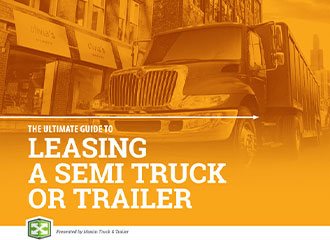19 Questions to Ask Before Leasing a Semi Truck or Trailer
 There used to be an expression in the new vehicle market a few years ago about “the fleecing of leasing,” much of which came from uninformed buyers getting into leases for the wrong reasons.
There used to be an expression in the new vehicle market a few years ago about “the fleecing of leasing,” much of which came from uninformed buyers getting into leases for the wrong reasons.That won’t happen in the corporate world if the decision-makers are well informed about the transportation options available to them and which ones make the most sense to their unique circumstances.
Jordna Harvey, national leasing manager at Maxim Truck & Trailer, can identify cost savings, help customers pinpoint their transportation costs down to the dime and help get the most out of their drivers.
This Guide answers to most common questions customers ask about heavy duty truck and trailer leasing—and also includes questions they should be asking.
Jordna Harvey, national leasing manager at Maxim Truck & Trailer, can identify cost savings, help customers pinpoint their transportation costs down to the dime and help get the most out of their drivers.
This Guide answers to most common questions customers ask about heavy duty truck and trailer leasing—and also includes questions they should be asking.
VIEW MAXIM'S LEASING HOMEPAGE
| 1 | What are the benefits to leasing a semi-truck? There can be many. For one, by dealing with a transportation expert, you can tap into their expertise for many money-saving measures, such as the optimal fleet size of both the truck and the engine that powers it. Lease providers should have strict maintenance requirements so the equipment is running at peak efficiency. When the lease is up, simply bring it back and lease a new truck. |
| 2 | What are the benefits of leasing for my transportation needs? It’s very difficult to do multiple things well. Companies have expertise in their core business but they can’t know the transportation field as well as a company in that area. Handling your own transportation needs when it’s not your core business can lead to extra costs. |
| 3 | What are the client’s expectations with transportation? They want the product delivered on time and in perfect condition. For example if the products require refrigeration they want to make sure it comes to them safe, that the temperature has been maintained, there is no damage to the product and that the people delivering it are professional. |
| 4 | What should a lease provider ask about your operation? The time of deliveries is a good place to start. If you only deliver during the day, is there potential that you could also deliver at night? Some trucks could be double-shifted to get some synergies. Also, if they know when your trucks are idle, it’s easier to schedule maintenance. You don’t maintain them from 9 a.m. to 5 p.m. on Monday to Friday. That’s when they’re being used. |
| 5 | How well do customers know their cost structure for transportation? Customers usually focus on the cost of the truck per month but the more important metric is the cost of your whole system over the life of the truck. If a company chooses a provider whose core competencies include driver training, licensing, access to GPS monitoring, and provide maintenance for customers, that can free up the clients’ people to focus on sales or another part of their business that generates revenue instead. |
| 6 | Are there savings opportunities that can come from the peaks and valleys in a delivery system? Yes. If your summer is slower, for example, you may have extra trucks in your fleet that you don’t need. You could have a core number of trucks, say five full-time, and two that you could use for six months of the year. That can save quite a bit of money. The per-truck savings would be about $15,000. |
| 7 | What financing mechanisms can be used to lease a truck? If you’re using a financing company or your bank, you usually have to come up with 10 to 15 per cent of the capital cost of the piece of equipment as a down payment. With leasing, you don’t need that. You’ll often just need the first and last month’s payments. That’s money you could put into your business, through inventory, buildings, or revenue generating personnel, as opposed to trucks which depreciate in value. |
| 8 | What options does a company have when deciding to move from owning its own vehicles to leasing them? Companies that own equipment are tasked with selling the equipment when it’s at the end of its useful life, which isn’t their core business. We could take those trucks, buy them out and replace them with leased trucks, either a straight buy or on consignment. Selling a truck isn’t an easy task. In some instances there are warranties that have to be provided, not to mention the difficult task of actually selling the truck. For example when you park it on your front lot with a ‘For Sale’ sign on it, somebody has to show it to a potential customer and possibly ensure that the equipment conforms to DOT requirements, etc… Sounds like a used truck center! |
| 9 | Can any truck do any delivery? No, you need to have the right truck for the right job. Twenty per cent of the trucks in the marketplace today are the wrong truck for the wrong job and that’s not effective for fuel economy. You see a lot of 24-foot box trucks on the highway that are not spec’d properly. But if you put a unit with a different engine and gearing ratio in it, the truck would cost a little more on the front end but the increased fuel economy in the long run will offset the monthly cost of the equipment. |
| 10 | Should transportation costs be measured per case, per delivery, per kilometer or per month? We mostly recommend using cost per kilometer. The number of cases you deliver can vary so that can impact the cost per delivery. Using true kilometers allows you know your costs. You don’t want to look at the fixed cost per truck per month because that can be a false number. Some companies make decisions on the monthly number. There are hidden costs with this metric (ie travel time, kms and fuel to deliver a truck to maintenance providers not readily accessibly or that don’t offer maintenance in the client’s yard) |
| 11 | What type of formal training should drivers have? Ninety-nine per cent of companies do not have driver training at all, they say, “here are the keys, get out there and drive.” They think it’s an extra cost. How hard is it to drive a truck? But you need to learn about things like turning radiuses. We offer programs to help them get the best fuel economy and how to use the tailback at the back of your truck. There are certain ways you can hurt yourself if you’re not careful. |
| 12 | What are the benefits of having a reward program for drivers? You can save a lot of money by offering a reward program for on-time deliveries, fuel economy and safe driving and it won’t cost you that much. When you reward drivers with incentives, it changes their tendencies and how they drive. This can result in increased quality and savings for your business. |
| 13 | What might a reward system cost? Yes. There’s price consistency, for starters. With regional providers, in a longer haul situation, you can be at the mercy of somebody in another city to get into a shop. If they didn’t lease you the truck, so potentially you’ll have to get in line with everybody else. With a national carrier, you’re more likely to go to the front of the line. |
| 14 | Are there benefits to working with a national carrier over a regional one? Getting into the warehouse can lead to very valuable conversations with the warehouse manager as well as seeing the products. As an example, sometimes a particular product doesn’t fit well on the tailgate and that can be a potential problem. If the product were to fall off the tailgate, there could be injuries. It is always important to have the proper equipment for the job. |
| 15 | Why is it important for a trucking company to see how products are stored and loaded on to trucks? Getting into the warehouse can lead to very valuable conversations with the warehouse manager as well as seeing the products. Sometimes a particular product doesn’t fit well on the tailgate and that can be a potential problem. If the whole thing tumbled off, there could be injuries. |
| 16 | What criteria do most firms used in choosing a service provider? A lot of them would choose monthly fixed cost, rather than number of service locations, response time, service levels, the proximity to your locations and after-hours service. We have mobile trucks that can go out and change oil in your yard without spilling a drop on the ground. We can do it on weekends or whenever the truck is available. Lower up-front costs usually end up costing you more in the long run. |
| 17 | Why should a company consider having global positioning monitoring systems (GPS) on their trucks? Because it allows you to monitor driving habits, such as idling, speeding, over-revving and hard braking, which leads to higher maintenance costs. You can also make sure your drivers are where they are suppose to be. It can also be used to ensure that on time deliveries are met and is very helpful in an accident situation. |
| 18 | What do companies typically dislike about transporting goods? They don’t like to do licensing, maintenance, pay fines or deal with parking and fuel. That can take a lot of time and they don’t realize the cost. I would say 75 per cent of small to medium-sized companies that do transportation don’t know their cost structure. |
| 19 | How much thought usually goes into the transportation needs of a company? A lot of the time the responsibility for transportation gets shifted from person to person. When they get asked why it’s being done a certain way, they’ll say, “We’ve always done it that way,” which obviously doesn’t mean it’s the best way of doing it. |







